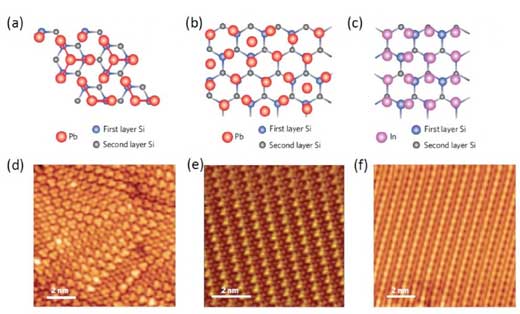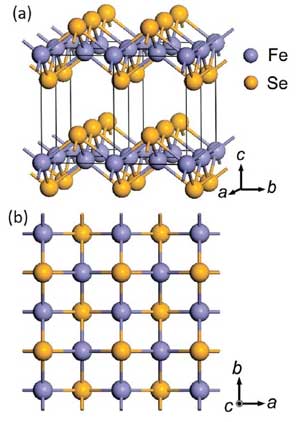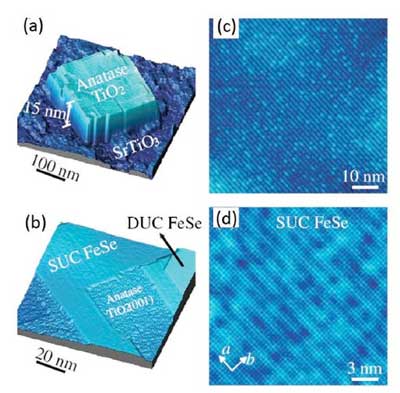| May 18, 2020 | |
Interfaces the key in atomically-thin, 'high temperature' superconductors(Nanowerk News) An international FLEET collaboration publishing a review (Small, "Atomically thin superconductors") of atomically-thin ‘high temperature’ superconductors finds that each has a common driving mechanism: interfaces. |
|
| The team, including researchers from the University of Wollongong, Monash University and Tsinghua University (Beijing), found that interfaces between materials were the key to superconductivity in all systems examined. | |
| The enhancement of superconductivity at interfaces (interface superconductivity enhancement effect) in atomically-thin superconductors is a unique tool for discovering new high-temperature superconductors, and could be used to finally unlock the elusive mechanism behind high-temperature superconductivity. | |
 |
|
| Three types of atomically thin metal films grown on silicon, including STM imaging. Left: SCI Pb/Si(111). Centre: √7 × √3 Pb/Si(111). Right: √7 × √3 In/Si(111). (Image: FLEET) | |
| Systems studied include: | |
|
|
|
| The review investigated the role of molecular-beam epitaxy (MBE), scanning tunnelling spectroscopy (STM/STS), scanning transmission electron microscopy (STEM), physical properties measurement system (PPMS), in fabricating and identifying atomically-thin superconductors. | |
 |
|
| β-FeSe lattice structure. a) 3D model. b) Top view. (Image: FLEET) | |
Superconductors: a background |
|
| Atomically-thin superconductors (whether iron based or copper based) are a type of ‘high temperature’ (Type II or unconventional) superconductor in that they have a transition temperature (Tc) much higher than a few degrees Kelvin above absolute zero. | |
| The driving force behind such Type II superconductors has remained elusive since their discovery in the 1980s. Unlike ‘conventional’ superconductors, it is clear they cannot be directly understood from the BCS (Bardeen, Cooper, and Schrieffer) electron-phonon coupling theory. | |
| In successive discoveries the transition temperature Tc has been driven steadily higher, and in the last decade there has been significant advances in the use of atomically-thin superconductors, both iron- and copper-based. | |
| These new discoveries challenge current theories regarding the superconducting mechanism of unconventional superconductors and indicate promising new directions for realising high-Tc superconductors. | |
| “The ultimate goal of the research of superconductivity is finding superconductors with a superconducting transition temperature (Tc) at or higher than room temperature,” says lead author Dr Zhi Li (University of Wollongong). | |
 |
|
| STM imaging (enlargements on right). Top: anatase TiO2 (001) island on SrTiO3(001) substrate. Bottom: SUC / DUC FeSe films on anatase TiO2. (Image: FLEET) | |
The study |
|
| The review investigated the role of molecular-beam epitaxy (MBE), scanning tunnelling spectroscopy (STM/STS), scanning transmission electron microscopy (STEM), physical properties measurement system (PPMS), in fabricating and identifying atomically-thin superconductors. | |
Novel materials study at FLEET |
|
| The properties of novel, atomically-thin materials are studied at FLEET, an Australian Research Council Centre of Excellence, within the Centre’s Enabling technology A. | |
| The Centre for Future Low-Energy Electronics Technologies (FLEET) is a collaboration of over a hundred researchers, seeking to develop ultra-low energy electronics to face the challenge of energy use in computation, which already consumes 8% of global electricity, and is doubling each decade. | |
| Each of FLEET’s three research themes are heavily enabled by these novel materials, including 2D topological materials (Research Theme 1), atomically thin semiconductors (as hosts for excitons in Research Theme 2, and for realising non-equilibrium topological phenomena in Research Theme 3). |
| Source: FLEET | |
|
Subscribe to a free copy of one of our daily Nanowerk Newsletter Email Digests with a compilation of all of the day's news. |
